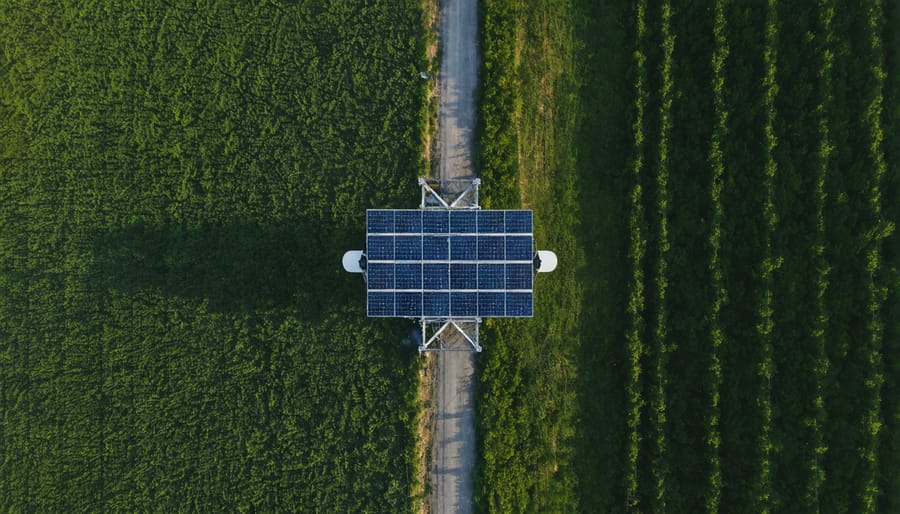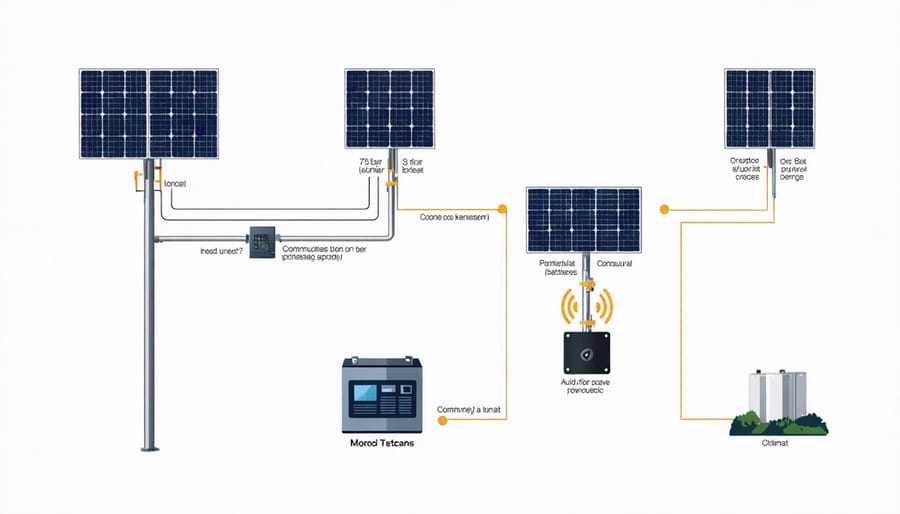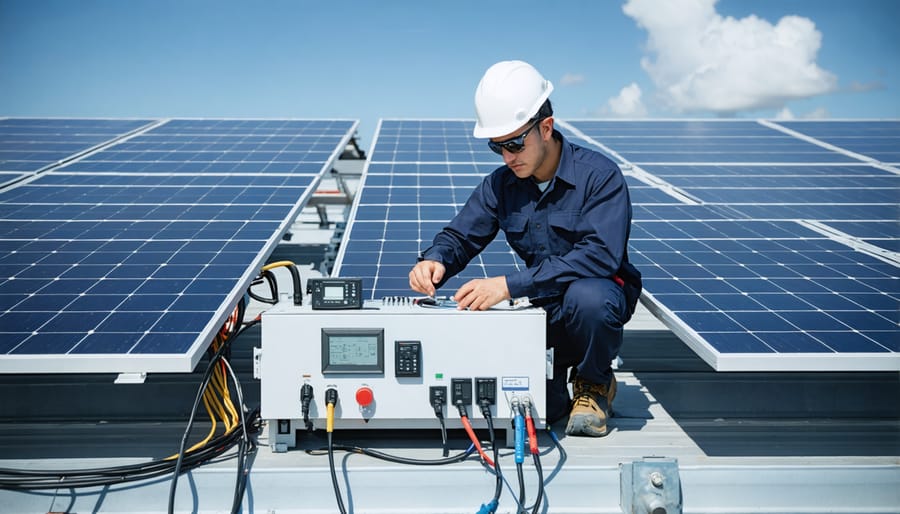Solar-Powered Communication Systems That Work When The Grid Fails

In an increasingly connected world, maintaining reliable communication beyond traditional infrastructure isn’t just a luxury—it’s becoming essential for resilience and independence. Off-grid communication systems, powered by sustainable energy sources like solar, enable vital connectivity in remote locations, during emergencies, and for operations requiring autonomous communication capabilities.
From remote European mountain refuges to industrial facilities operating in challenging environments, these systems serve as critical lifelines when conventional networks fail or aren’t available. Modern off-grid communications merge robust radio technology, satellite systems, and renewable energy solutions to create dependable networks that operate independently from the power grid.
The evolution of solar-powered communication equipment has transformed how we approach remote connectivity, offering solutions that are both environmentally conscious and technically sophisticated. Whether supporting emergency services, powering remote monitoring stations, or enabling business operations in isolated areas, these systems represent a crucial intersection of sustainability and technological advancement.
For European organizations and communities seeking communication resilience, understanding the fundamentals of off-grid systems has become paramount—particularly as climate challenges and energy security concerns continue to reshape our approach to critical infrastructure.
Why Off-Grid Communication Matters in Modern Europe
Emergency Response Scenarios
In emergency situations, reliable off-grid communications become crucial for safety and coordination. Natural disasters like floods, storms, or earthquakes can severely damage conventional communication infrastructure, leaving communities isolated. Solar-powered communication systems provide a resilient alternative, maintaining essential connectivity when traditional networks fail.
Power outages, whether caused by severe weather or grid instability, pose significant challenges for emergency response teams. Off-grid communication solutions equipped with solar panels and battery storage ensure continuous operation, enabling first responders to coordinate rescue efforts effectively. These systems can support various communication methods, from basic radio communications to satellite internet connections.
European regions experiencing increased extreme weather events have recognised the value of solar-powered emergency communication networks. Many municipalities now incorporate these systems into their disaster preparedness plans, establishing solar-powered communication hubs in strategic locations. These hubs serve as vital information centres during crises, supporting emergency services, civilian coordination, and critical infrastructure management.
For optimal emergency preparedness, these systems should include redundant communication methods and sufficient energy storage capacity to operate through extended periods of adverse weather conditions.

Remote Operations Support
Remote industrial operations rely heavily on dependable off-grid communications to maintain efficiency and safety. In mining operations across Europe, solar-powered communication systems enable real-time monitoring of equipment, environmental conditions, and worker safety protocols. These systems integrate satellite connectivity with local mesh networks to ensure continuous operation, even in the most challenging underground environments.
The energy sector similarly depends on robust communication infrastructure for managing remote facilities. Wind farms and solar installations use these systems for performance monitoring, maintenance scheduling, and grid integration. Modern off-grid solutions incorporate redundant communication paths, combining cellular, satellite, and radio technologies to guarantee uninterrupted data transmission.
Remote facilities, such as research stations and agricultural operations, benefit from integrated communication solutions that support both operational needs and staff welfare. These systems typically feature energy-efficient designs that balance power consumption with communication reliability. Advanced battery storage and smart power management ensure continuous operation during extended periods of limited solar exposure, while supporting essential services like weather monitoring, security systems, and emergency communications.

Essential Components of Solar-Powered Communication Systems
Solar Panel Configuration
Effective solar panel configuration is crucial for maintaining reliable off-grid communication systems. For optimal performance, the solar array should be sized to generate at least 20% more power than the daily communication equipment requirements, accounting for efficiency losses and weather variations.
A typical configuration for a small communication site includes 4-6 high-efficiency monocrystalline panels, each rated between 300-400 watts, arranged in a series-parallel configuration. This setup ensures consistent power delivery even during partial shading or reduced sunlight conditions.
Panel orientation plays a vital role in system efficiency. In European installations, panels should face south with an optimal tilt angle between 30-45 degrees, depending on the specific latitude. Smart mounting solutions with seasonal adjustment capabilities can increase energy yield by up to 15%.
The configuration must include proper surge protection and monitoring systems to safeguard sensitive communication equipment. Modern installations typically incorporate micro-inverters or power optimizers for each panel, enabling granular performance monitoring and enhanced system reliability.
For scalability and future expansion, leaving additional mounting space and electrical capacity is recommended. This forward-thinking approach allows for easy system upgrades as communication needs evolve. Regular maintenance access should also be considered during initial panel layout planning, ensuring safe and efficient cleaning and inspection procedures.
Battery Storage Solutions
Effective battery storage is crucial for maintaining reliable off-grid communications. Modern energy storage solutions offer various options, each suited to different operational requirements and environmental conditions.
Lithium-ion batteries remain the preferred choice for most installations, offering excellent energy density, long cycle life, and minimal maintenance needs. For European installations, temperature-controlled enclosures are recommended to maintain optimal battery performance during extreme weather conditions. A typical system should provide 3-5 days of autonomy, considering local weather patterns and critical communication needs.
When planning battery capacity, consider these key factors:
– Daily power consumption of communication equipment
– Expected duration of cloudy weather periods
– Temperature variations affecting battery efficiency
– System voltage requirements (12V, 24V, or 48V)
– Future expansion needs
For maximum reliability, implement a battery management system (BMS) to monitor state of charge, temperature, and individual cell performance. Modern BMS solutions can integrate with remote monitoring systems, enabling proactive maintenance and system optimization.
Professional installation and regular maintenance schedules ensure optimal performance and longevity of battery systems. European regulations require proper disposal and recycling procedures, which should be factored into long-term planning.
Communication Equipment Integration
Modern off-grid communication systems require careful integration of various devices, each with specific power requirements and compatibility considerations. Common equipment includes two-way radios, satellite phones, wireless routers, and cellular signal boosters, all of which must be properly matched to your solar power system’s capabilities.
Two-way radios typically consume between 2-5 watts during transmission and 0.2-0.5 watts in standby mode. Satellite phones demand more power, usually requiring 5-8 watts during calls and 1-2 watts in standby. Wireless routers and cellular boosters generally need consistent power supply, consuming 10-20 watts continuously.
To ensure reliable operation, communication equipment must be connected with proper system grounding and surge protection. Power conditioning equipment, such as voltage regulators and DC-DC converters, helps maintain stable power delivery and protects sensitive communication devices from voltage fluctuations.
When planning your system, factor in peak power demands during simultaneous device operation. Include a 20% power buffer in your calculations to accommodate future expansion and maintain system efficiency. Modern communication equipment often features power-saving modes, which can significantly reduce overall energy consumption and extend battery life during periods of limited solar generation.
Implementation and Maintenance
System Design Considerations
When planning an effective off-grid communication system, several critical factors must be considered alongside your off-grid solar system design. Power requirements stand as a fundamental consideration, determining both the solar capacity needed and battery storage specifications. System designers must calculate the total energy consumption of all communication equipment, including transmitters, receivers, and auxiliary devices.
Reliability factors heavily into the planning phase, with redundancy measures often proving essential. This includes implementing backup power solutions and alternative communication paths to ensure continuous operation during adverse conditions. Weather resistance and environmental protection must be incorporated, particularly for European climates with varying seasonal challenges.
Coverage requirements and terrain analysis play crucial roles in determining equipment placement and signal strength needs. The system should account for geographical obstacles and potential interference sources while maintaining optimal signal quality across the intended coverage area.
Scalability and future-proofing deserve careful attention during the planning stage. The system should accommodate potential expansion and technological upgrades without requiring complete redesign. This includes selecting compatible components and maintaining flexibility in the infrastructure.
Security considerations are paramount, encompassing both physical protection of equipment and data encryption protocols. The system must safeguard against unauthorized access while ensuring ease of maintenance for authorized personnel.

Maintenance Protocol
Regular maintenance is crucial for ensuring the reliability of off-grid communication systems. Implement a quarterly inspection schedule that includes checking solar panel cleanliness, battery connections, and antenna alignments. Clean solar panels with non-abrasive materials and water to maintain optimal energy generation, particularly important during periods of limited sunlight.
Monitor battery health monthly by measuring voltage levels and checking for signs of corrosion or damage. Replace batteries every 3-5 years, depending on usage patterns and environmental conditions. Inspect all cable connections bi-annually, ensuring weatherproof seals remain intact and protecting against moisture ingress.
Keep detailed maintenance logs recording system performance, repairs, and component replacements. This documentation helps identify patterns and predict potential issues before they cause system failures. Essential maintenance tools should include a multimeter, cable testing equipment, and appropriate cleaning supplies.
For antenna systems, conduct signal strength tests quarterly and adjust alignments as needed. Check guy-wires and mounting hardware for proper tension and signs of wear. In areas with extreme weather conditions, increase inspection frequency during challenging seasons.
Establish emergency repair protocols and maintain a stock of critical spare parts on-site. Train multiple team members in basic maintenance procedures to ensure continuous system operation. Consider implementing remote monitoring solutions to receive early warnings of potential system issues and optimize maintenance scheduling.
Future-Proofing Your Communication Infrastructure
As technology continues to evolve rapidly, future-proofing your off-grid communication infrastructure requires strategic planning and awareness of emerging solutions. The integration of mobile microgrid technology has revolutionized how we approach sustainable communications, offering unprecedented flexibility and scalability.
Key considerations for future-ready communication systems include modular design principles that allow for easy upgrades and expansions. This approach enables systems to accommodate new communication protocols and increased bandwidth requirements without requiring complete overhauls. Implementation of software-defined radio (SDR) technology provides adaptability to emerging communication standards while maintaining compatibility with existing infrastructure.
The rise of Low Earth Orbit (LEO) satellite constellations presents exciting opportunities for enhanced connectivity options. These systems offer lower latency and higher bandwidth capabilities compared to traditional satellite communications, making them valuable additions to existing off-grid setups. Planning for integration with these networks ensures long-term viability of your communication infrastructure.
Edge computing capabilities are becoming increasingly crucial for off-grid communications. By incorporating edge processing nodes within your system, you can optimize data handling and reduce bandwidth requirements while enabling advanced applications like AI-driven system management and predictive maintenance.
Scalability considerations should focus on power management systems that can grow with your needs. This includes implementing smart load management, advanced energy storage solutions, and intelligent power distribution systems that can automatically adjust to changing demands and conditions.
Security infrastructure must evolve alongside communication capabilities. Implementation of quantum-resistant encryption protocols and regular security update pathways ensures your system remains protected against future cyber threats. Additionally, establishing redundant communication paths and backup systems enhances overall reliability and resilience.
By considering these elements in your infrastructure planning, you create a robust foundation that can adapt to technological advances while maintaining operational efficiency and reliability.
In today’s interconnected world, establishing reliable off-grid communication systems is crucial for ensuring operational continuity and safety across European solar installations. The integration of these systems with solar power solutions offers a sustainable, independent approach to maintaining essential communications, particularly in remote locations or during grid disruptions.
By implementing a combination of satellite systems, radio networks, and cellular solutions powered by solar energy, organisations can create robust communication infrastructures that operate reliably regardless of traditional grid availability. The key lies in careful planning, selecting appropriate technology combinations, and ensuring proper system sizing to match specific communication needs and local solar conditions.
As European businesses and industries continue to embrace renewable energy solutions, the importance of reliable off-grid communications becomes increasingly evident. Whether supporting remote monitoring systems, enabling emergency communications, or maintaining operational connectivity, these solar-powered solutions provide the independence and reliability required in modern operations.
We encourage facility managers and decision-makers to evaluate their current communication infrastructure and consider implementing solar-powered alternatives. Start by assessing your specific needs, consulting with qualified providers, and developing a comprehensive implementation plan that accounts for both current requirements and future scalability.
Remember, successful off-grid communication systems require regular maintenance and periodic updates to ensure optimal performance. By taking action today, you’re investing in a more resilient and sustainable operational future.
Leave a Reply